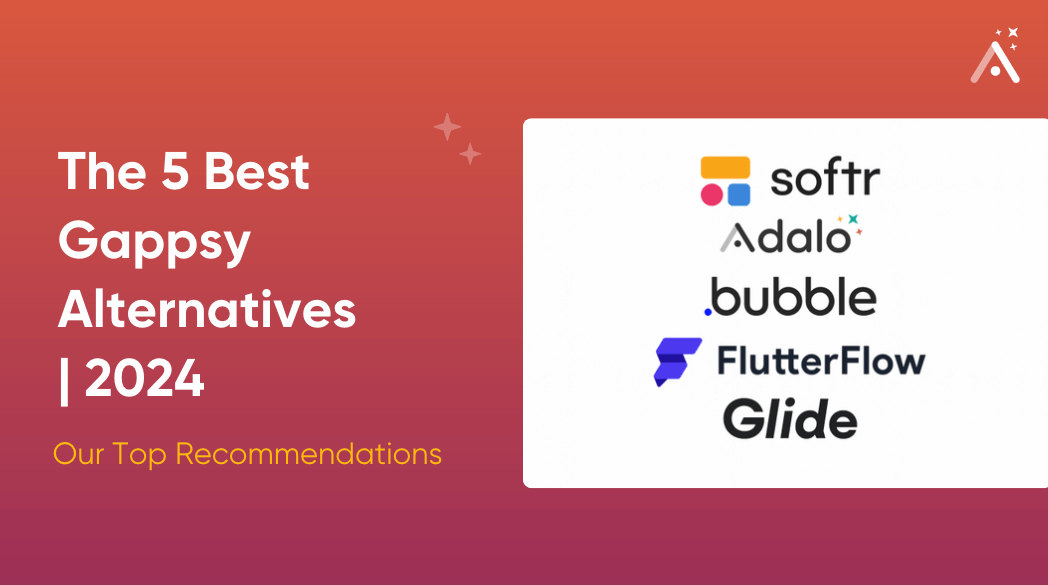The Bottom Line: Fliplet offers enough features and tools for creating simple apps. However, it has a few drawbacks that make building larger apps difficult and expensive.
Pros:
- Unlimited storage space can allow for enormous apps.
- You can make up the 3 web apps using the free version.
- You’ll be able to publish your apps to the Apple App Store or Google Play Store.
Cons:
- An unconventional pricing tier could make scaling pricey.
- Major integrations are only offered on the enterprise version.
- To sign up for the free version, you must enter a phone number, and Fliplet will contact you for marketing purposes.
- Fliplet’s app-building interface has a slower load time than most other app-building platforms.
Pricing:
Fliplet has a free version that allows you to get used to the app-building interface and create up to 3 web apps. Its public version starts at $9.90/month (billed monthly) for 100 users. If you anticipate having more than 100 users, you’ll have to contact Fliplet directly.
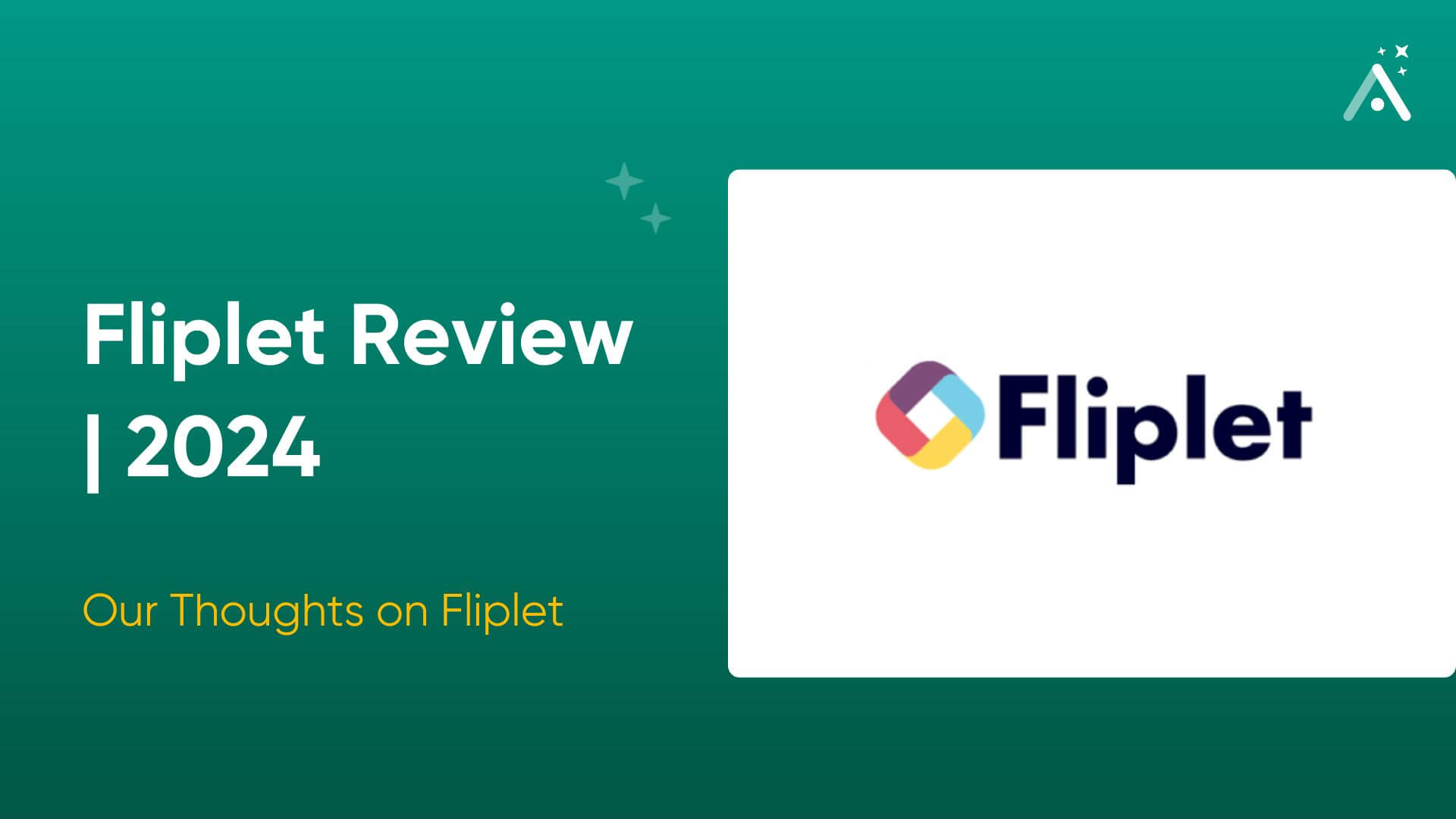
Fliplet Review: What is Fliplet?
Fliplet is a no-code web and native mobile app-building platform that features an easy-to-use drag-and-drop interface. You can publish your app to the web, which users will access with an internet browser, or release it on the app stores to reach a larger audience.
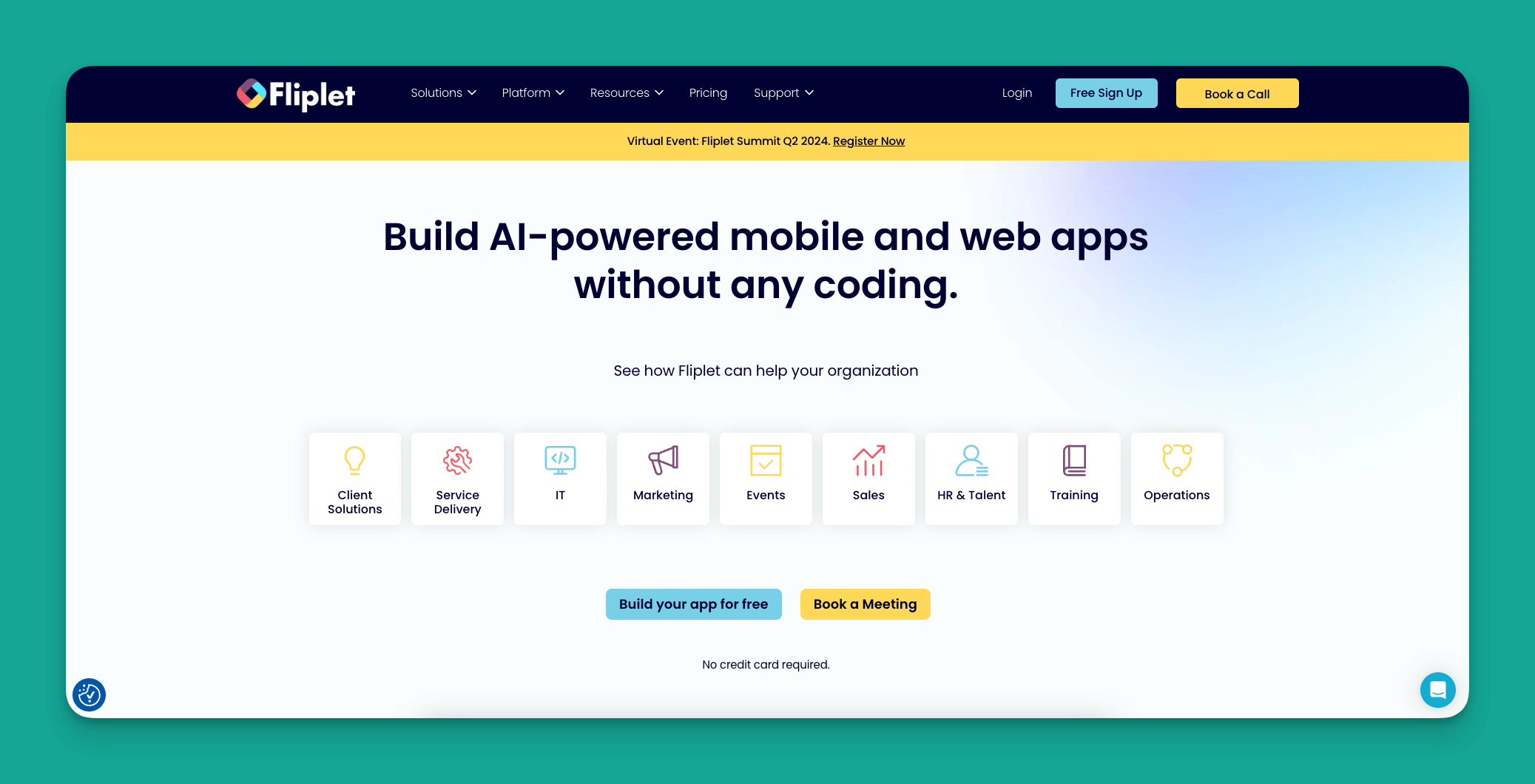
After signing up with Fliplet, you must answer a few basic questions about your app and your app-building experience. At the end of the onboarding process, Fliplet requires you to enter a valid phone number to proceed to the app-building interface.
Moments later, you will receive a text message. Some users may welcome this unusual requirement as an opportunity to get questions answered quickly, while others might find it an unnecessary annoyance.
Once you’ve provided all the necessary information, Fliplet will take you to its template selection page — Fliplet actually calls its templates “solutions.” You’ll find 17 different solutions (templates) for a wide variety of use cases.
Here are a few select solutions (templates) you’ll find for making the following different apps:
- Learning (online courses)
- Project Management
- Event Management
- Community/Social Media
- Office Management Management
- Sales Enablement
- E-commerce
- Data Capture
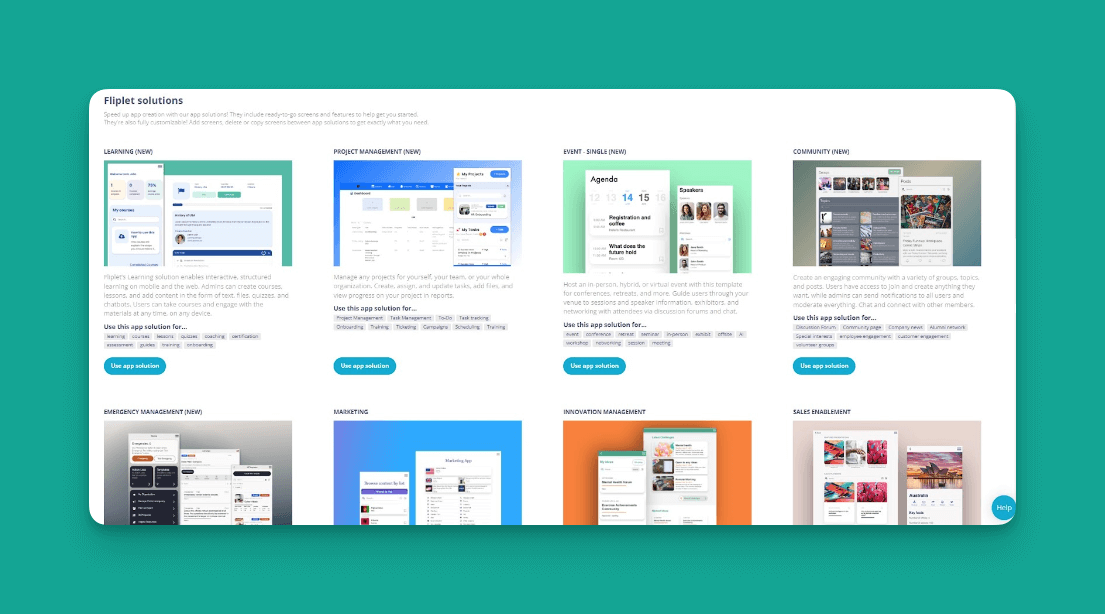
Click on the blue button below the template description if you’re curious about the features of each template type. Fliplet provides a 4-paragraph description illustrating each template’s features, such as special tools, screens, and integrations.
Reading the descriptions really helps you determine which template you need for the app you want to build.
For instance, you’ll learn about built-in stock management features and Stripe integration for the e-commerce template, social media integrations for the sales template, and the ability to create a floor plan for an event management template.
Fliplet Review: Building With Fliplet
Once you’ve selected your app’s template, it’s time to build! Conveniently, Fliplet lets you choose the main parts of your app’s aesthetics, like the font and background color, before you arrive at the app-building interface.
The app-building interface is straightforward and simple to understand. Because Fliplet automatically launches in “Preview” mode, make sure you select the “Edit” tab on the upper right-hand side of your building interface.
On your left side, you’ll see a standard drop-down dashboard that allows you to select the screens you want to edit. To add new screens, click the “Add New Screens” button at the bottom of the dashboard.
You’ll also find the building canvas at the center of your screen. Click on the icons in the upper center of your screen to adjust the size of your building canvas and see how your app will look on a desktop, iPad, several iPhone, and Samsung Phone models.
To edit and adjust your app’s components, click on the desired component in your building canvas. On the right side of your screen, you can edit your app’s components, add lists, upload photos, and more. Just drag the elements over to your building interface.
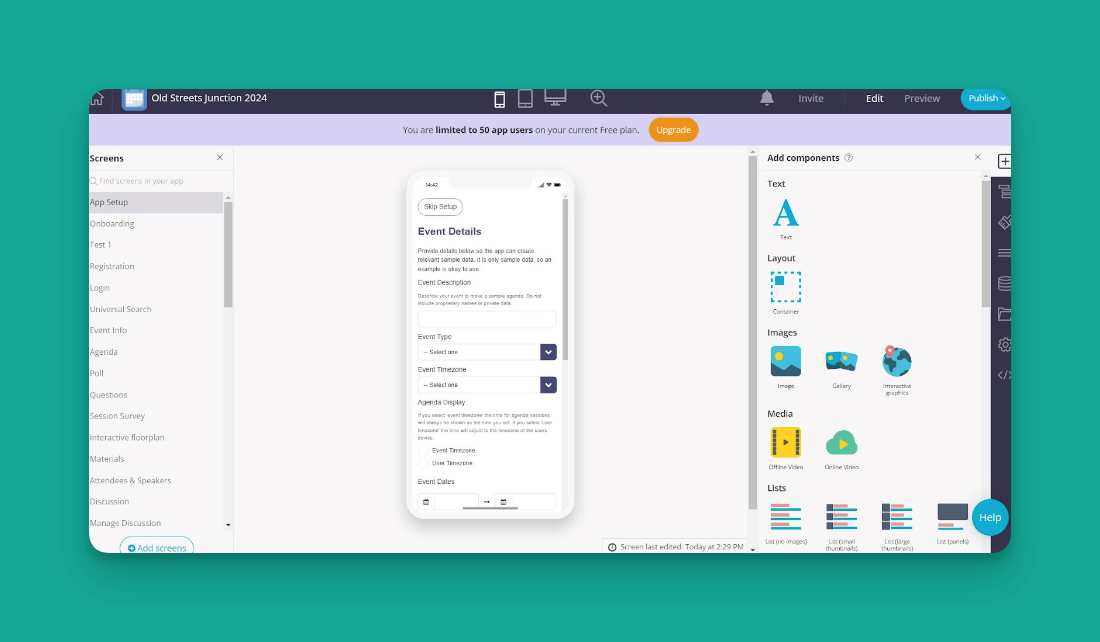
Fliplet’s Highlights
- Fliplet’s building experience is super simple. Its drag-and-drop interface allows you to use it right after you sign up without a tutorial.
- While Fliplet’s ecosystem isn’t as extensive as peers like Adalo’s and Bubble’s, it’s large enough to help you learn the interface complete with the Fliplet Academy and Community Forum, and even developer tools and code that techies can add to their apps.
- If you’re a developer, Fliplet might be a great option. It lets you enter your own code to create your app’s unique features.
Fliplet’s Hang Ups
- The app-building interface loads very slowly, especially when you’re toggling from screen to screen.
- While Fliplet does have its own database, the only external database you can connect is a SQL one.
- WIth Fliplet, you pay for the number of users. If your user base grows past a certain point, you’ll have to pay a higher monthly price.
Is Fliplet Right For You?
Fliplet is an easy-to-use app builder, but it has a limited audience. Select Fliplet if:
- You need an internal app, such as a project management tool, with a small number of users.
- You want an easy-to-use and intuitive drag-and-drop interface.
- You have technical experience and want to patch in a few lines of your own code to build out a special feature.
However, you should take a look at other app builders if:
- You want to scale your app.
- You want a fast and responsive app-building interface with little to no lag time.
- You want to integrate with a wide variety of third-party apps but don’t want to pay enterprise-level prices.
What Kinds of Apps Can I Build With Fliplet?
While Fliplet has the tools, templates, and integrations to build almost any app, its pricing and user restrictions don’t justify making apps that are complex or will reach a large audience.
So, if you’re a restaurant with hundreds of customers who would use your booking app, for instance, expect to pay Fliplet an exorbitant amount.
However, if you’re a small business and need to make a simple and limited internal app, like a project management board, marketing app, or CRM tool, Fliplet may be a cost-effective choice for you.
And, if you have programming experience, you can use your own code to build out certain features.
Keep in mind, though, that in order for your app to remain cost-effective, you can only make it available to a limited audience of no more than 100 users, and you’ll only have access to very few integrations, like social media and Stripe. This limits your app’s flexibility and power.
Fliplet Pricing: Is it Worth it?
While Fliplet’s free version lets you get used to the app-building interface and publish 3 apps to the web, you’ll need to purchase the Public Version to publish to the Apple App Store and Google Play Store.
The public version gives you unlimited storage space, but the pricing depends on the number of app users you have. Here are the pricing tiers, based on the user number offered by the Public Version, billed monthly:
- 0-100: $9.90
- 101-300: $29.90
- 301-500: $49.90
- 501-1,000: $99.90
- 1,001-5,000: $499.90
Fliplet offers integrations with Zapier, Power Automate, Logic Apps, and more with its Enterprise Version. While you’ll need to contact Fliplet directly for pricing, you’ll most likely have to pay between $1,000 and $5,000 per month.
Fliplet Alternatives: What Other Tools Should You Try?
If you need an app-building platform that offers more possibilities than Fliplet, check these out:
- Adalo, if you want an easy-to-use app builder with enough power and integrations to make super-simple apps, large and complex ones, and everything in between.
- Draftbit, if you’re technical and want to add your own code on top of several integrations — plus, you get to keep your source code.
- Softr, if you’re looking to build an internal business tool from a pre-existing database using a simple building interface.
Verdict
So, now you get to learn my feelings on Fliplet! Should you get it now, shortlist it, or avoid it?
Get it now if you want to build a simple, not-so-powerful app with a limited user base.
Shortlist it if you know you won’t have a large number of users but are unsure how many integrations you want to include in your app.
If you’re a freelancer, entrepreneur, or small or medium-sized business owner and want to build an app that you can scale to a growing customer base, look no further than Adalo. For $36/month, you’ll get tons of integrations, elements, and features made by the developer community.
Adalo has a super-easy drag-and-drop interface that you can use right out of the box. You’ll be able to edit your app free-form on Adalo’s intuitive building canvas. When you finish building your app, publish it to the web, Apple App Store, and Google Play Store so your users can easily download it to their mobile devices.
.png)






